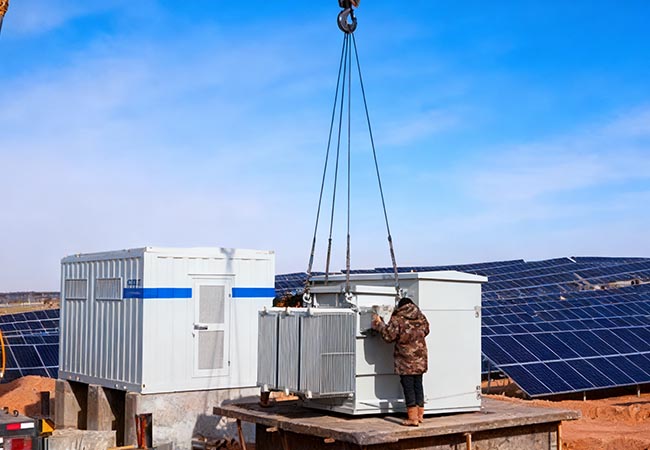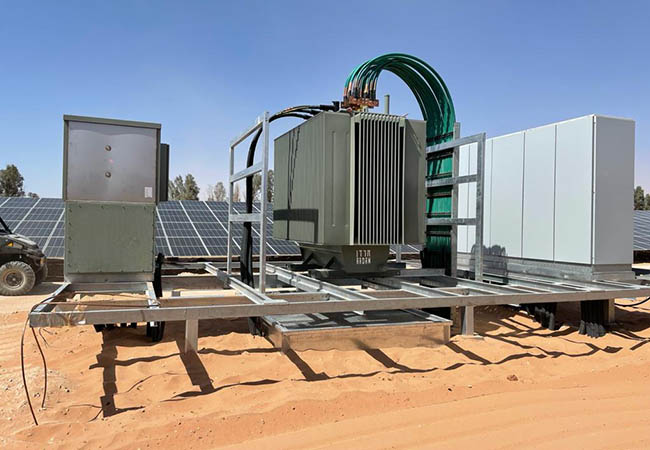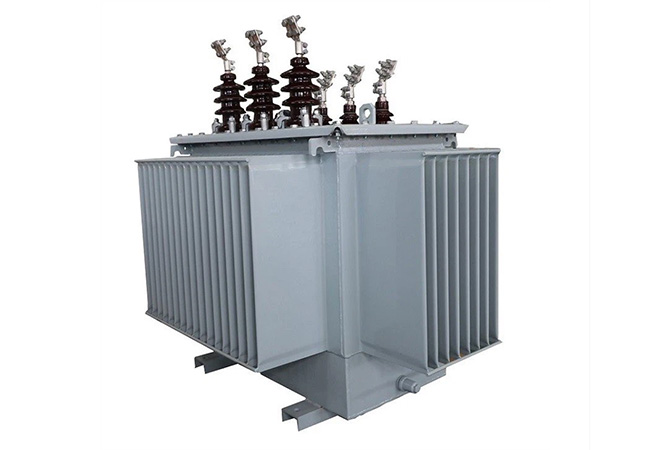Solar PV Step-Up Transformers: A Comprehensive Guide from ZTelec Transformer
10-31 2025 | By:
Boosting Efficiency for Utility-Scale and Commercial PV Installations)
Introduction
As solar photovoltaic (PV) installations continue to scale globally, the need for reliable, efficient step-up transformers has never been greater. At ZTelec Transformer, we specialize in designing and manufacturing high-performance PV step-up transformers—whether dry-type, oil-immersed or pad-mounted—to match diverse project requirements. In this article we’ll explore the types, applications, key parameters and selection guidelines for PV step-up transformers, helping EPCs, solar farm owners and specifiers understand what sets PV-specific units apart.
Why PV Step-Up Transformers Are Different from Conventional Distribution Units
Solar PV systems impose specific demands on transformers. Unlike standard distribution transformers, PV step-up units must handle inverter output, variable load profiles, harmonic currents, outdoor exposure, and often higher temperature or dust/salt environments.
Key differentiators include:
-
Harmonic tolerance: PV inverters inject non-linear currents, requiring transformers designed with higher K-factor or low harmonic loss shielding.
-
Outdoor and ruggedized construction: Units may be installed in desert, coastal or high-altitude solar farms and must resist corrosion, UV, moisture.
-
Voltage step-up from inverter to medium voltage: Instead of typical distribution down-step, PV step-up often raises from e.g., 600 V/800 V to 33 kV or higher.
-
Low no-load and load losses: Since many hours may be off-peak or partial load, loss minimization is critical.
At ZTelec Transformer, our PV step-up models incorporate these features—ensuring compatibility with string or central inverters, robust vector group options, and tailored cooling and enclosure designs.
Transformer Types for PV Applications
Dry-Type PV Step-Up Transformers
Dry-type (air-insulated) transformers employ solid insulation instead of oil. They are ideal for indoor installations or where fire risk must be minimized.
Typical features:
-
Insulation class F (155 °C) or H (180 °C)
-
Capacities from tens of kVA up to several MVA (often < 10 MVA)
-
Indoor or semi-outdoor enclosures, ventilation or forced-air cooled
Applications: rooftop or building-integrated PV systems, battery energy storage system (BESS) zones, compact sub-stations.
Oil-Immersed PV Step-Up Transformers
Oil-immersed (liquid-filled) transformers are the workhorses for medium-/large-scale solar farms. They provide excellent thermal performance and higher capacity ratings.
Typical features:
-
Ratings from several MVA up to tens or hundreds of MVA
-
Primary voltages: e.g., 6 kV–220 kV (depending on grid)
-
Cooling methods: ONAN (oil natural air natural) / ONAF (oil natural air forced)
-
Outdoor tank, radiators, bushings, protection accessories
Applications: utility-scale PV farms, central inverter stations, solar-plus-storage with grid interconnection.
Pad-Mounted Transformers for PV-Grid Interface
Pad-mounted transformers are outdoor units installed at ground level (on “pad”) to interface between PV collection system and distribution network. They may be oil-filled or dry type depending on capacity, and often used in distributed/utility scale installations.
Typical features:
-
Three-phase units, compact footprint
-
Outdoor enclosure, often with tamper-resistant design
-
Primary/secondary voltage combinations for PV collection (e.g., 34.5 kV/0.4 kV)
Applications: community solar plants, distributed generation sites, BESS/EV charging hubs paired with PV.
Typical PV Step-Up Transformer Parameters & Specifications
Here are key parameters to specify when selecting a PV step-up transformer, and sample values commonly seen in the industry.
| Parameter | Typical Range / Sample Value | Notes |
|---|---|---|
| Rated Power / Capacity | 500kva/1200kva/ 1600kva /2000kva/ 2500kva
up to 35MVA (depending on scale) |
Match to inverter/array output plus margin. |
| Primary Voltage | 400V,600 V, 800 V, 6 kV, 12 kV, 24 kV, 33 kV, 46 kV | Many PV collection voltages are low (e.g., 600 V) and step-up to medium voltage grid. |
| Secondary Voltage | 12 kV, 22 kV, 33 kV, 35 kV | Depends on local grid interconnection requirement. |
| Frequency | 50 Hz or 60 Hz | Match regional grid. |
| Vector Group | e.g., Dyn11, YNd11, YNd1, Yyn0, etc. | Determines grounding / ungrounded and harmonic handling. |
| Impedance (Z %) | 5 %–7.5 % typical for large oil-immersed units | Affects fault current, voltage drop, short circuit behavior. |
| Tapping Range | ±2×2.5 % or greater | To adjust to varying PV input or grid voltage. |
| Insulation Level / BIL | e.g., up to 200 kV BIL depending on HV side. | Must match outdoor environment and system voltage. |
| Cooling Method | Dry type: Air-cooled (AN/AF); Oil type: ONAN/ONAF. | Choose based on capacity and site. |
| Environment / Protection | Outdoor rated, corrosion resistant paint, IP54/65 for enclosure | Especially for desert or coastal PV sites. |
| Harmonic handling / K-factor | Special winding design or electrostatic shield to reduce harmonic heating. | PV inverters produce harmonic currents. |
Example specification (oil-immersed 2.5 MVA unit):
-
0.6/22 kV, three-phase, Dyn11, Impedance 6 %, Tap ±2×2.5 %, ONAN cooling, compliant with IEC 60076.
Example specification (large utility scale): -
25 MVA-300 MVA, 115 kV primary, output 66/35/33/22/11 kV, ONAN/ONAF, compliance IEC/ANSI.
How to Select the Right PV Step-Up Transformer (ZTelec Transformer Guide)
1. Match to PV Inverter Output & Array Configuration
Understand your inverter output voltage and maximum power. For example, if your array + inverter output is 800 V/1.2 MVA, you might select a ~1.5 MVA transformer to allow margin for future expansion or safety factor.
2. Determine Grid Interconnection Voltage & Topology
Know the grid voltage (e.g., 33 kV) and local regulations for vector groups and grounding. ZTelec Transformer offers flexibility in vector group (e.g., Dyn11), tapping, and design for both centralized and string inverter setups.
3. Choose Transformer Type Based on Site Conditions & Capacity
-
For indoor/roof-mounted, fire-sensitive sites → dry-type.
-
For outdoor large-scale solar farms → oil-immersed.
-
For distributed generation or pad installation → pad-mounted variant.
ZTelec Transformer recommends oil-immersed for ≥ 5 MVA rating, and dry-type for smaller, indoor installations.
4. Consider Environmental & Operational Demands
Address harmonic distortion (select K-factor or electrostatic shield design), extreme ambient temperature, altitude, dust/salt exposure, cooling method. ZTelec Transformer’s PV units are manufactured with corrosion-resistant tanks, UV-resistant coatings and optional monitoring systems.
5. Verify Key Parameters & Standards
Ensure compliance with standards (IEC 60076, ANSI/IEEE, local code) and verify parameters such as BIL, no-load loss, cooling method, impedance, temperature rise, accessories (OTI, WTI, surge arrester). ZTelec Transformer supports customized options to match wide variety of PV projects.
6. Plan for Maintenance & Lifecycle
Solar farms expect 25-30+ years service life. Choose transformers with low loss, monitoring features, and robust design. ZTelec Transformer provides lifecycle support, dry-type or oil change cycles, and documented QA.
Why Choose ZTelec Transformer for Your PV Project?
-
Industry Experience: ZTelec Transformer has delivered PV step-up solutions for utility, C&I and BESS applications worldwide.
-
Full Range Offering: From dry-type indoor units to oil-immersed outdoor pad-mounted modules, we cover the full spectrum.
-
Customization: Primary/secondary voltages, tapping ranges, vector groups, cooling methods, enclosure ratings—all tailor-made per project.
-
High-Quality Manufacturing: We use high-grade materials, low-loss cores, optimized windings, and robust outdoor protection.
-
Global Standards & Support: Our products comply with IEC, IEEE, ANSI standards and we provide documentation, testing, and after-sales services.
-
Competitive Cost & Delivery: Efficient manufacturing combined with optimized logistics ensures a strong value proposition.
Conclusion
As solar PV deployment accelerates, the role of the transformer cannot be understated. A purpose-designed PV step-up transformer—whether dry-type, oil-immersed or pad-mounted—ensures safe, efficient, reliable energy transmission from inverter to grid. Choosing the right type, matching it to system voltages, ensuring compatibility with harmonics and environment, and selecting a trusted manufacturer like ZTelec Transformer are critical success factors.
If you’re specifying or procuring a PV step-up transformer for your next solar farm or rooftop project, reach out to ZTelec Transformer today for a tailored solution built for long-term performance.
You may also find these interesting:









